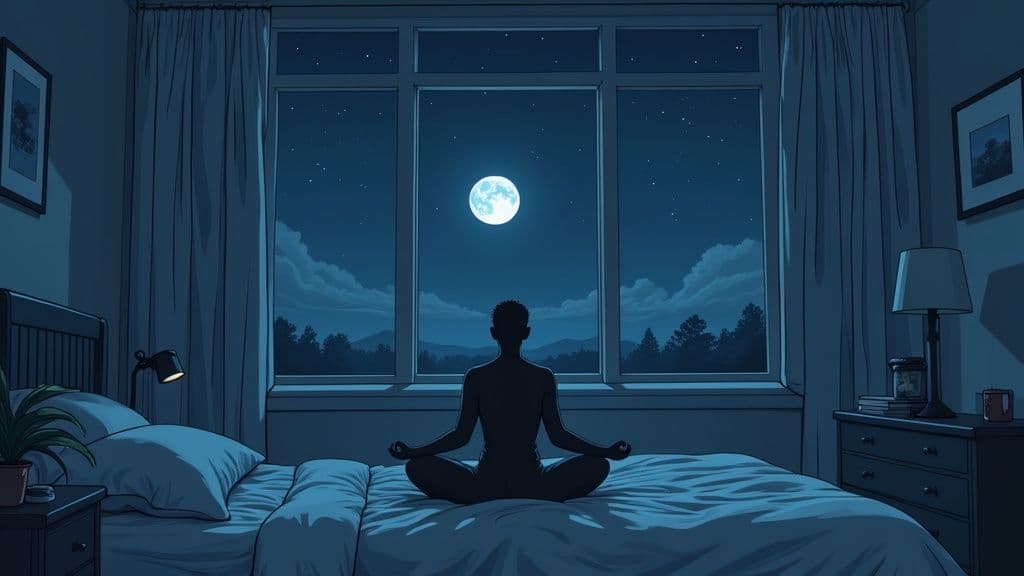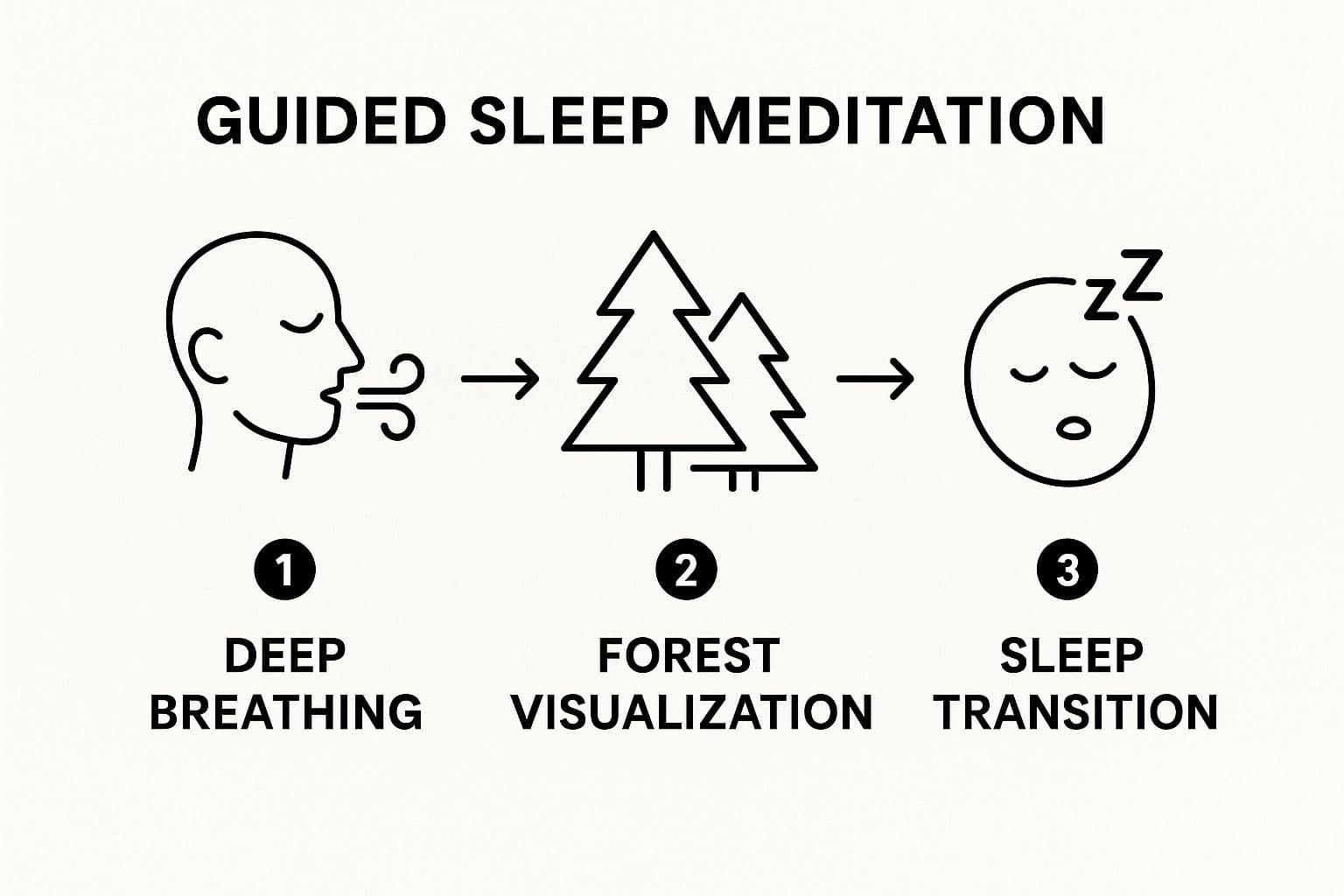Drift Off With a Meditation Story for Sleep
Discover how a meditation story for sleep can calm your mind and guide you into deep, restorative rest. End bedtime anxiety and wake up refreshed.
A meditation story for sleep isn't your average audiobook. It's a special kind of narrative, built from the ground up to quiet a racing mind and gently guide you toward rest. The key difference? It intentionally sidesteps all conflict and suspense. Instead, it weaves simple storytelling together with mindfulness techniques, creating an experience that is deeply soothing and peaceful.
This gentle approach is designed to distract you from the day's worries, giving your body's natural sleep processes the space they need to take over.
How Meditation Stories Guide You to Sleep

Picture your mind at bedtime. For many of us, it’s like a bustling city street, loud with the noise of lingering worries, tomorrow's to-do list, and thoughts that pop up out of nowhere. A meditation story for sleep is like a trusted guide who takes you by the hand and leads you away from that commotion, down a quiet, moonlit path. Its only job isn't to entertain, but to help your cognitive gears slow down and finally stop turning for the night.
These stories work by giving your busy brain a single, peaceful thing to focus on. Instead of wrestling with anxieties, your mind is invited to follow a simple, meandering plot through a calm, beautiful landscape. It’s a gentle form of mental redirection, shifting your attention from internal stress to external, calming imagery.
The Power of Gentle Distraction
The narrative is purposefully slow and descriptive, rich with sensory details that draw you in. You might be guided to imagine the cool feeling of moss under your feet or hear the soft rustle of leaves in an enchanted grove. This focus on the present moment—a core idea in mindfulness—helps break the cycle of looping thoughts that so often keeps us awake.
By engaging your imagination in a world that is safe and free of conflict, the story effectively quiets the brain's endless "chatter." This mental calming triggers a direct physical response:
Slowing the Heart Rate: As your mind unwinds, your "fight-or-flight" response stands down, allowing your heart rate to naturally decrease.
Deepening the Breath: The narrator's calm, rhythmic voice encourages you to breathe more slowly and deeply, signaling to your body that you are safe.
Releasing Muscle Tension: The focus on sensory details helps you let go of physical tension you might not even realize you're holding onto in your shoulders, jaw, or back.
This blend of storytelling and mindfulness is more than just a pleasant distraction; it's a practical method for preparing the mind and body for deep, restorative rest. It's an invitation to let go of the day and drift into sleep.
The Science-Backed Connection
This gentle approach is supported by a growing body of evidence. We know that mindfulness meditation can significantly improve sleep quality. In fact, a major meta-analysis of 18 trials involving over 1,600 people found that mindfulness practices had a real, positive effect on sleep compared to groups that didn't use them. This shows just how valuable these techniques are for tackling sleep problems rooted in stress and anxiety.
Ultimately, a meditation story for sleep provides a structured, gentle path to relaxation. For anyone just starting out and looking to build a new sleep habit, understanding how this works is a great first step. As you see how these stories can guide you to sleep, exploring other effective sleep solutions can also help you build a more robust toolkit for better rest. You can also dive deeper into starting your own practice in our guide on sleep meditation for beginners.
The Science of Storytelling for Restful Sleep

Ever wondered why a simple, gentle story can work wonders for your sleep when other methods fall short? The secret is in the fascinating way a good narrative interacts with your brain. When you're trying to wind down, your prefrontal cortex—the part of your brain that acts like a CEO, handling planning and problem-solving—can get stuck running in anxious circles.
A meditation story gives that part of your brain a new, much calmer job. Instead of spinning on tomorrow’s to-do list or replaying a stressful chat, your mind is invited to follow a peaceful, easygoing plot. It's like asking a frantic project manager to stop staring at complex spreadsheets and instead, just calmly watch a beautiful painting.
This simple shift is incredibly powerful for breaking the cycle of thoughts that keeps you staring at the ceiling. The story becomes a soft anchor, grounding your attention in a serene, imaginary world and signaling to your mind that it’s finally safe to let go.
Engaging Your Body's Relaxation Response
Beyond just redirecting your racing thoughts, a sleep story has a direct, physical effect on your body. The narrator's calm, rhythmic voice is a huge part of this. It’s designed to activate your parasympathetic nervous system, which is your body’s natural "rest and digest" mode.
Think of this system as the antidote to your stressful "fight or flight" response. As you listen to a slow, melodic voice, it triggers a whole cascade of physiological changes that are all about deep relaxation.
Lowers Cortisol: The soothing audio helps dial down your levels of cortisol, the primary stress hormone.
Slows Breathing: Your breath naturally starts to deepen and slow, mimicking the breathing patterns you have when you're already asleep.
Releases Muscle Tension: As your nervous system calms, you’ll feel the tension held in your shoulders, jaw, and back begin to dissolve.
By combining a gentle mental focus with physical relaxation cues, a sleep story creates the perfect conditions for your body and mind to transition into a state of rest, paving the way for a deeper sleep.
The Proven Power of Mindfulness
This whole approach is deeply rooted in the principles of mindfulness, which has a solid track record of success. Research has shown that mindfulness meditation programs lead to significant improvements in sleep quality, with results that are often comparable to established treatments like medication.
One study, for example, highlighted an effect size of 0.89 in improving sleep among older adults—a powerful testament to its effectiveness. Considering that insomnia affects up to 10% of people globally, findings like these are a huge deal. You can explore the full research to better understand these sleep quality improvements.
A well-crafted meditation story for sleep takes these core principles and wraps them in a gentle narrative, turning a simple tale into a potent tool for getting the restful night you deserve.
Creating Your Ideal Bedtime Wind-Down Ritual
A meditation story for sleep works best when it’s the final, calming anchor in a solid bedtime ritual. Think of it like a lighthouse guiding a ship into harbor; the journey is a lot smoother when the waters are already calm. Putting together a deliberate wind-down routine is your way of signaling to your mind and body that it’s time to power down for rest.
This process doesn’t have to be complicated. The goal is to build a sequence of simple, soothing activities that progressively relax you. Consistency is the magic ingredient here—over time, your body will learn to associate these steps with sleep, making it that much easier to drift off each night.
Setting The Perfect Sleep Environment
Your bedroom should be a sanctuary for sleep. The environment you create can either support or completely sabotage your efforts to unwind. Before you even think about pressing play on a story, take a few moments to get your space ready.
A few small tweaks can make a huge difference:
Dim the Lights: Lowering the lights an hour or so before bed helps kickstart your brain's production of melatonin, the natural hormone that tells your body it's time for sleep.
Cool the Room: A cooler room temperature, right around 65°F or 18°C, is widely considered perfect for sleep. It helps lower your core body temperature, which is a natural part of the sleep cycle.
Silence Notifications: Make sure your phone is on silent or "do not disturb." Nothing pulls you out of a relaxed state faster than a random alert.
By crafting a peaceful atmosphere, you’re clearing the runway for relaxation. This makes the transition into a meditative state much smoother, allowing the story to do its best work.
To really dial in your wind-down, think about the overall ambiance of your sleep space. Exploring some minimalist bedroom design ideas can help you create an uncluttered, serene environment that practically begs you to fall asleep.
Building Your Personalized Routine
Once your environment is set, it's time to build your personal wind-down sequence. The image below shows the core steps within a guided sleep meditation, but your own ritual can start well before that.

This simple visual shows how each step logically builds on the last, guiding your mind from active awareness to a state of deep, peaceful rest.
Your pre-story ritual could be anything that feels calming to you. Maybe it's sipping a caffeine-free herbal tea, doing some light stretching, or journaling to get any lingering thoughts from the day out of your head. The key is to make the meditation story for sleep the very last thing you do.
To help you get started, here are a few core elements you can weave into your own routine.
Elements of an Effective Pre-Sleep Routine
This table breaks down some of the most effective components for a relaxing bedtime ritual.
Routine Element | Best Practice | Why It Works |
Tech Curfew | Put away all screens (phone, TV, tablet) at least 60-90 minutes before bed. | The blue light from screens suppresses melatonin and keeps your brain wired and alert. |
Gentle Movement | Try light yoga or simple stretches to release physical tension from the day. | Eases muscle tightness and signals to your body that it's time to relax, not work. |
Mindful Activity | Journaling, reading a physical book, or listening to calm music. | Helps transition your mind away from the day's stressors and into a quieter state. |
Warm Beverage | Sip on a caffeine-free herbal tea like chamomile or lavender. | The warmth is physically soothing, and certain herbs have natural calming properties. |
Meditation Story | Make this the final step. Get comfortable in bed and press play. | It serves as the ultimate signal for sleep, guiding your now-relaxed mind into rest. |
For more ideas on what to include, check out our full guide to building a relaxing evening routine. By making this a consistent practice, you create a powerful, predictable pathway to a restful night.
Finding the Right Meditation Story for You

With a seemingly endless library of sleep stories out there, picking the right one can feel a little overwhelming. But try to think of it less as a task and more like a gentle exploration to figure out what truly soothes your mind. The perfect meditation story for sleep is deeply personal; what sends one person drifting off might not click with another.
The whole point is to experiment and notice what actually helps you unwind. The process of choosing a story can even become a mindful, enjoyable part of your nightly routine.
Key Elements to Consider
When you're browsing for a story, a few key ingredients can make all the difference. You're looking for that perfect recipe that feels comforting and gives your mind permission to finally let go of the day’s stress.
Here are a few things to listen for:
Narrator's Voice: Does the voice feel calming to you? A slow, melodic, and steady tone usually works best. Some people prefer a lower, deeper voice, while others find a softer, higher-pitched voice more relaxing.
Thematic Content: Where does your mind feel safest? Do you find comfort in nature scenes, cozy fireside settings, or imaginative fantasy worlds? Choose a theme that feels inherently pleasant and safe.
Background Ambiance: Many stories layer in soft music, nature sounds like rain, or even white noise. Decide if these extras help you relax or if you'd rather have a simple, unaccompanied narration.
The shift toward mindfulness for better health is undeniable. All over the world, meditation has become a go-to tool for improving sleep. In the United States, a huge number of adults practice it regularly. In fact, research from 2014 showed that about 40% of U.S. adults meditated at least weekly, a trend largely driven by the need to manage stress and get better rest. You can dive deeper into these meditation trends and their impact.
Tips for Effective Experimentation
Don't be surprised if it takes a few tries to find your perfect story. If the first one you listen to isn't a great fit, don't get discouraged. Just approach the process with a sense of curiosity and patience.
The most effective sleep story is one that you barely remember hearing the end of. Its purpose is to be a gentle, pleasant pathway to sleep, not a captivating performance you stay awake to finish.
Give each story a fair shot, maybe listening for a few nights before you make a decision. You could even jot down what you like or dislike about each one—the pace, the soundscape, the imagery. Over time, you’ll start to get a really clear sense of what works for you. Our own collection of stories for sleep is a great place to begin your exploration.
A Guided Sleep Story: The Whispering Grove
Go ahead and find a comfortable position. Let your body settle, feeling its weight sink gently into the surface beneath you. When you're ready, close your eyes and take a slow, deep breath in... followed by a long, soft breath out.
Let your hands rest loosely wherever they’ve fallen. Feel your shoulders relax, dropping away from your ears. Release any tension you might be holding in your jaw, letting your mouth part just a little.
With your next breath, picture a soft, warm light beginning to glow right at the top of your head. As you breathe out, feel this warmth spread downwards, loosening the tiny muscles in your forehead, around your eyes, and across your cheeks. This gentle wave of relaxation flows down through your neck, spills over your shoulders, and travels all the way down your arms to the very tips of your fingers.
Take another slow breath in, and as you exhale, feel the warmth continue its journey. It moves down your chest and back, soothing every muscle it touches. It flows into your stomach, down through your hips, and along your legs, finally reaching your feet and toes. Your entire body is now held in a soft, peaceful warmth. You are safe. You are comfortable.
Entering the Forest Path
Now, in your mind's eye, imagine you're standing at the edge of an ancient, quiet forest. The air is cool and smells of pine and damp earth. A narrow, winding path of soft moss and fallen leaves leads into the trees, inviting you to begin your journey.
As you take your first step onto the path, you notice how spongy and quiet the ground is under your feet. The moss cushions every footfall, making your steps completely silent. Towering trees with silvery bark rise on either side, their branches weaving together to form a protective canopy high above. Dappled sunlight filters through the leaves, creating shifting patterns of light and shadow on the path ahead.
You begin to walk, your pace unhurried and easy. The only sounds are the gentle rustle of leaves in a soft breeze and the distant, melodic call of a bird. With each step, you feel the lingering thoughts of the day begin to fade away, replaced by a simple awareness of this peaceful place. The forest is calm, and so are you.
Discovering the Crystal Stream
You walk deeper into the woods, feeling more relaxed with every step you take. The path begins to slope gently downwards, and soon you hear a new sound—the soft, musical murmur of running water.
Following the sound, you come to a clearing. In its center, a crystal-clear stream trickles over smooth, grey stones. The water is so pure you can see every single pebble and strand of green moss on the stream bed. You find a large, flat rock at the water's edge, warmed by a patch of sunlight, and decide to sit for a moment.
You dip your fingers into the cool water, feeling its gentle current flow around them. You watch as a single, vibrant blue dragonfly lands on a fern nearby, its delicate wings shimmering in the light. This place is entirely at peace. There's nothing for you to do here, nothing to solve. There is only this moment of pure, simple stillness as you observe the quiet beauty around you.
The stream flows without effort, following its natural course. In the same way, your breath flows in and out, a steady, quiet rhythm. You don’t have to do anything. Just let it be.
Reaching the Whispering Grove
After a while, you stand and continue along the path, which now runs alongside the stream. The trees become even older and larger here, their trunks covered in a thick, velvety moss. This is the heart of the forest—The Whispering Grove.
It’s called this because the wind moving through the leaves creates a sound like a soft, continuous whisper. It’s a soothing, comforting sound that seems to carry all your remaining worries away with it. You find a patch of especially soft moss and lie down, feeling completely supported by the earth beneath you.
Looking up through the canopy, you see tiny glimpses of the deepening sky. The whispers of the leaves and the gentle burble of the stream are the only sounds. A profound sense of peace settles over you. Here, in this grove, you are completely safe and held. The forest is breathing with you—a slow, deep, ancient rhythm.
Feel the relaxation in your body deepen. Feel the stillness in your mind. This grove is a place of rest. A place where you can let go completely. As the whispering leaves lull you, allow your mind to drift. There is nowhere else to be, nothing else to do. Simply rest. Allow the gentle sounds and the deep peace of the Whispering Grove to carry you into a deep and restorative sleep. Sleep now.
Common Questions About Sleep Meditation Stories
Diving into the world of sleep stories can bring up a few questions, especially if you're new to the idea. It’s natural to wonder if you’re “doing it right” or what to expect. Let's clear up some of the common uncertainties and help you build this new, restful habit with confidence.
The good news is, the beauty of a meditation story lies in its simplicity. There are no complicated rules to follow. Your only goal is to get comfortable, listen, and let the gentle narrative guide you toward a state of calm.
What If I Fall Asleep Before the Story Ends?
That’s not just okay—it’s the entire point! Falling asleep midway through is the clearest sign that the story is working exactly as it should. Think of it less like a movie you need to see to the end and more like a tool designed to gently distract your mind from the day's worries.
The story is a pathway, not a destination. It's like a lullaby; you measure its success by how quickly it soothes you to sleep, not by whether you heard every note. So don't worry about missing the conclusion. Your mind has already soaked up the benefits of the calming atmosphere as you drift off.
The most successful sleep story is the one you never hear the ending of. Its primary job is to make itself obsolete by guiding you into deep, restful sleep.
This process lets your brain switch off from the active listening we use for podcasts or music, creating the perfect mental space for rest.
Can I Just Use Any Audiobook?
While you can certainly try listening to a regular audiobook at bedtime, it's often far less effective for sleep. Audiobooks are designed to be engaging. They have compelling plots, rich character development, and dramatic tension—all the things meant to capture your attention and keep your brain buzzing. That's the exact opposite of what you need when you're trying to wind down.
A meditation story for sleep, on the other hand, is built with a completely different purpose.
Monotonous Tones: The narrator’s voice is intentionally steady and melodic. The goal is to be soothing, not stimulating.
Simple Plots: The narrative deliberately avoids conflict, suspense, or complex twists that would demand your mental engagement.
Slow Pacing: The delivery is unhurried, encouraging your heart rate and breathing to naturally slow down right along with it.
These stories are designed to be pleasantly boring, giving your active mind permission to finally switch off and let sleep take over.
How Long Does It Take for Sleep Stories to Work?
This is different for everyone, so a little patience goes a long way. Some people feel an immediate sense of relief and fall asleep faster on the very first night. For others, especially if you've been dealing with sleep troubles or high anxiety for a while, it might take a few nights to feel the full effect.
Consistency is your best friend here. By making a sleep story a regular part of your bedtime ritual, you’re training your brain to recognize it as a powerful cue for sleep. Just like any new habit, it gets easier over time. Soon, your mind and body will learn to associate the calm narrative with deep relaxation, making it easier and easier to drift off peacefully.
At Otherworld Tales, we create immersive, fantasy-inspired sleep stories designed to transport you far from the worries of the day. Explore our library of guided narratives and discover your new favorite path to a peaceful night's rest at https://www.otherworldtales.com.